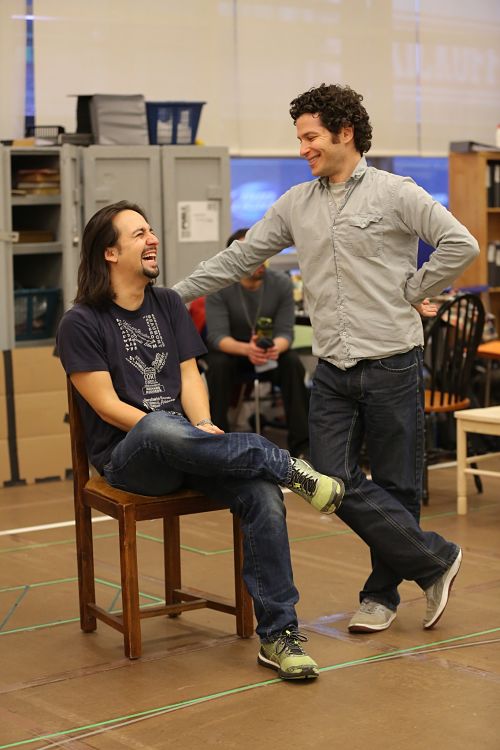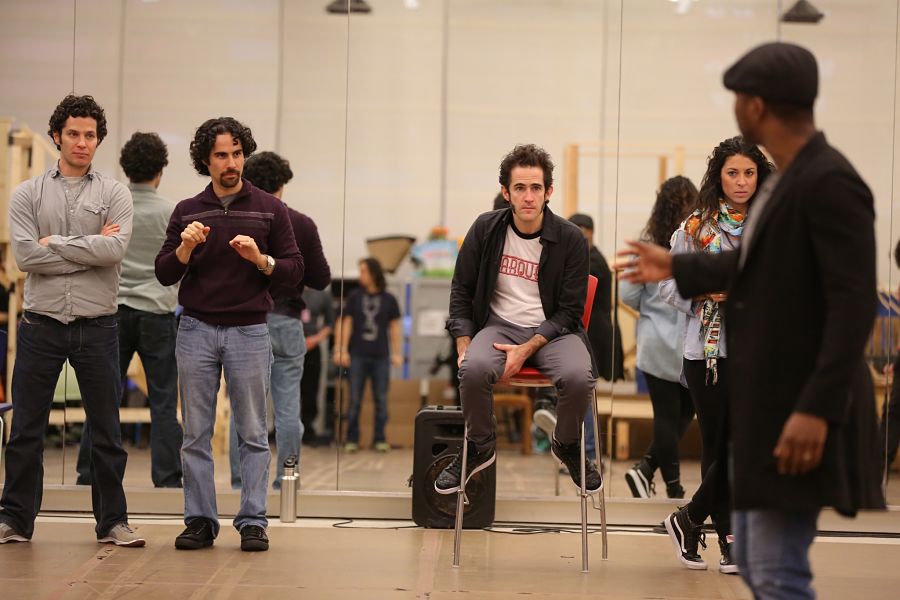He may now seem universally beloved, but a few of Lin-Manuel Miranda’s now-indispensable collaborators weren’t immediately sold on the composer/lyricist’s talent.
Oskar Eustis, artistic director of the Public Theater, where Miranda’s explosive hit Hamilton bowed Off-Broadway earlier this year, had professional reasons for skepticism: Passing Strange, the first of his nonprofit theatre’s musicals to transfer to the Broadway under his lead, moved the same season as Miranda’s In the Heights transferred from an Off-Broadway run.
“I was really hoping Passing Strange would win the Tony for best musical, so when In the Heights won, I was definitely less than non-competitive,” confesses Eustis, adding that he “grudgingly admired” In the Heights after he finally saw it. “I have to admit I didn’t necessarily take him as seriously as I should have.”
Director Thomas Kail, who helmed both In the Heights and Hamilton, had a similar experience. Three years ahead of Miranda at Wesleyan University, Kail didn’t meet Miranda at school but heard about him through friends. In fact, the closest he came to interacting with his future collaborator while at school was when Miranda borrowed lights from one of Kail’s projects. “He was stealing from me!” the director jokes.
When Kail moved to New York to start his theatre company, Back House Productions, some mutual friends who’d seen Miranda’s presentation of an early-version of Heights at Wesleyan told Kail that it should be the company’s first production. “I said, ‘Well I’m the professional, let me be the judge of that,’” Kail recalls.
Music director and orchestrator Alex Lacamoire’s first conversation with Miranda was over the phone, and it wasn’t even about working together. Miranda was looking for a potential cowriter on Heights, and he was grilling Lacamoire for leads.
All three, of course, are now some of Miranda’s closest collaborators and confidantes. (In a nod to Hamilton‘s historical basis, Kail, Lacamoire, choreographer Andy Blankenbuehler, and Miranda are collectively nicknamed “The Cabinet.”) And each will be cheering on—or, in Lacamoire’s case, leading from the pit—at Hamilton‘s opening tonight at Broadway’s Richard Rodgers Theatre.
“Lin is just unbearably charming,” Eustis effuses. “He’s the most delightful person to be around.” Eustis admits thinking that “if he’s that charming and delightful, there must be some level of pretense.” But “if there is, I haven’t found it yet.”
Lacamoire calls Kail the “life coach” of the group, and Kail retorts, “That’s just because Alex is married to a life coach.” But it has been Kail’s strong suit since Heights to be the task manager and cheerleader, and to make sure everyone is reaching their goals and deadlines. The Hamilton development process has taken almost six years, and over that time, Kail has set markers for the team.

“I didn’t have any designs on the show being anything but, Can we write another song?” says Kail, who adds that he knew the show belonged onstage early on. (Miranda initially conceived it as a mixtape.) “The one thing I find really useful with this particular group is just planting some flags on the horizon so we can march toward them. And Lin responds very well to that, and once the flow state begins with him, it’s really just about maintaining it. Once it really opens up, as it started to do in 2012 and 2013, it was such a constant production from him. It was about harnessing it then, as well as focusing on targets for us to hit.”
Though Lacamoire never found Miranda a cowriter (he briefly tried working with a playwright on Hamilton, as he did with Quiara Alegria Hudes on In the Heights, but he didn’t seem to need one in this case), Lacamoire appreciates how much Miranda invites him into the creative process. Often an orchestrator will come in after a score is completely finished, but Lacamoire involved earlier than that.
“Lin is really open to suggestions,” Lacamoire says, adding that sometimes Miranda would just bring in a chord sheet to work from, other times a fully formed demo. He cites the Act 2 opener, “What’d I Miss?,” in which Thomas Jefferson returns from France, as a case in which the two went back and forth. “When he brings in a piece of music, he really gives me the freedom to explore stuff. He really allows me to put a stamp on it. I really get to play and suggest.”
Lacamoire also worked with Miranda on Bring It On the Musical, which is where he really learned how to orchestrate live music and electronic music together. The show, which played at the Alliance Theatre in Atlanta and the Ahmanson Theatre in Los Angeles before coming to Broadway, gave Lacamoire a necessary three tries to get the orchestrations right.
“It’s really easy to get the electronic component overblown,” he says, adding that they had “way too many synthesizers” on tour in Bring It On. Now Lacamoire has a mix of some prerecorded tracks—as in the number “Satisfied,” which begins with the voice of Hamilton’s sister-in-law, Angelica Schuyler (Renée Elise Goldsberry), echoing in the speakers before Goldsberry actually starts singing live—and some live effects, as in “Wait for It,” which adds echoes to the live performance of Leslie Odom Jr. as Aaron Burr.
For Kail, this process has been the most mature yet—sort of.
“We were coming out of our early adulthood with Heights—Lin started writing it when he was a late teenager, basically,” Kail says. “This just felt like the adult version of us working on a show. As adults, what do you do? You write about young, scrappy revolutionaries who are passionate, because you’re like, ‘Oh, that’s not us anymore!’”
Eustis, for one, was thrilled to be in “the room where it happens” for Hamilton. Some of his favorite moments from the process were watching Miranda and his team make changes and tweaks during the preview process at the Public.
“There was a rewrite that he did on a song called ‘Washington on Your Side,’” Eustis says. “It was funny and dark and fully expressed, but it didn’t move the action of the play forward. So Lin activated the song by making it the song in which Jefferson resigns from the cabinet. It’s just beautiful to watch him figure out how to take a beautiful thing and then activate it so it unleashes its full dramatic potential. That’s the kind of brain he has; it’s thrilling to be around.”
For his part, Miranda returns the compliment.
“It’s impossible to overstate it,” Miranda says of the importance of his team. “We’re all pretty good editors of each other’s work. I bring a song in to them, and it’s like a pit crew with a car. The song’s going to come out leaner and faster as a result.”


